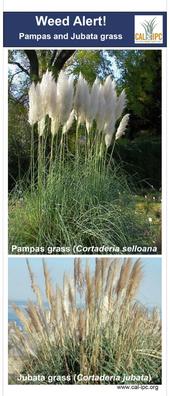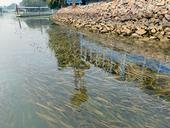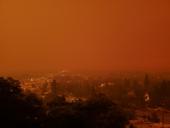- Author: Belinda J. Messenger-Sikes
- Posted by: Gale Perez

Invasive Pest Spotlight: Pampasgrass & Jubatagrass
The invasive pest spotlight focuses on emerging or potential invasive pests in California. In this issue, we cover the invasive plants pampasgrass and jubatagrass.
Pampasgrass & jubatagrass facts
Pampasgrass (Figure 1, top) is a common ornamental flandscape plant that readily naturalizes throughout California's coastal areas and some interior regions. Historically, pampasgrass was planted for erosion control, but it has since escaped cultivation and spread along sandy, moist ditch banks throughout coastal regions of southern California. Pampagrass can also grow in the hot, dry...
- Author: John Madsen

A new invader was found in the Sacramento-San Joaquin River Delta (hereafter “Delta”) by California State Parks, Division of Boating and Waterways (“CDBW”). The new weed is Australian ribbonweed, Vallisneria australis S.W.L. Jacobs and Les. First described as V. gigantea, the taxonomic name has been revised to V. australis (see photos). It has multiple common names, including ribbonweed, eel grass, and others. Native to Australia, it has been spread to New Zealand, Europe, and North America. Ribbonweed is widely sold in both aquatic gardening and aquarium trades.
Ribbonweed forms fertile seed pods, but the predominant form of spread is vegetative by stolon fragments. It forms...
- Posted by: Gale Perez

The Department of Plant Sciences at the University of California, Davis, seeks an Assistant Professor of Cooperative Extension in Invasive Weed and Restoration Ecology. Faculty in the Department are engaged in developing and disseminating comprehensive basic and applied knowledge regarding all aspects of plant sciences related to managed and natural ecosystems. This position fills a key gap in research and Extension leadership in weed management and ecological restoration in rangelands, wildlands and natural areas.
Rangelands, wildlands and natural areas span about 75% of California's land area and provide critical economic benefits and ecological services. The spread of weedy and invasive plants...
- Author: Thomas Getts

I have called California Home for the past 6 years since starting this position and the past two summers are unlike any I have experienced in the west. Growing up in Colorado I remember the smokey skys from the Hayman fire and ash raining down from the High Park fire, which blackened my grandparents' property. Moving to Susanville, we had smoke and ash from the 2016 Willard fire, the 2018 Whaleback fire and the 2019 Walker fire, but none of it was unlike what I was used to back home.
Raining ash and thick air was a novel experience to many of my new friends in Susanville, who had grown up in the Midwest. Where friends I had made who were local said 2016-2019 “was nothing” compared to the 65,000 acre Moonlight fire,...
- Posted by: Gale Perez

From the Journal of Aquatic Plant Management—Special Issue Vol. 59s 2021
An overview of the Delta Region Areawide Aquatic Weed Project for improved control of invasive aquatic weeds in the Sacramento–San Joaquin Delta
Patrick J. Moran, John D. Madsen, Paul D. Pratt, David L. Bubenheim, Edward Hard, Thomas Jabusch, and Raymond I. Carruthers
Abstract
The 27,540-ha (68,000-acre)...


